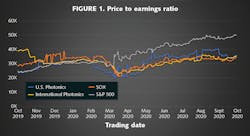Photonics stock indices update: The new-new billionaires of photonics
In the last few months, we have seen a fresh $10 billion of public market value attained following nearly $1 billion of capital inflows into just three photonics companies—Velodyne (NASDAQ: VLDR), Luminar (NASDAQ: LAZR), and QuantumCTek (Shanghai STAR Market: 688027). Each is playing into macro-trends in hyper-growth markets that big investors are focused on in auto-transportation (autotech) technology and quantum information.
The investors looking at public firms in such projected hyper-growth markets are focused on making valuation and stock-buying decisions on “out years.” By that, we mean forecasts in five to seven years rather than the near-term metrics that established firms are valued on, such as trailing or next-year price-to-earnings (PE) or enterprise-value-to-revenue as shown in our September 30, 2020 updated photonics stock indices charts (see Figs 1-3). The companies listed in these U.S. and International photonics stock indices are available at https://bit.ly/PhotonicsStockIndices.The quantum market, while still in early stages of developing, has been garnering substantial corporate- and VC-type investments. QuantumCTek embodies this market as the first material quantum IPO, with its stock rising over 900% on its first day of trading post-IPO in July 2020 on the Shanghai NASDAQ-modeled exchange, hitting a market value of over $4 billion. With revenue of over $37 million and profits of $7 million, it has indeed accomplished much in terms of business traction and captured investor support for its position in quantum communications (quantum key distribution, or QKD), which some market research firms forecast to become a $850 million market in 2025, and growing to $4 billion in 2029. While the stock price has since declined from that peak, it still sported a nearly $3 billion value at the September 30, 2020 close.
Autotech, or more broadly transportation technology, has seen huge inflows of funds from private firms for several years and in recent months a crush of flows in the public markets largely due to special purpose acquisition corporation (SPAC) mergers. SPACs are public firms also known as “blank check” firms that raise cash, often $200 million to $1 billion in an IPO that is essentially backing a small team of known investors and executives that use this capital to hunt for a core acquisition of a “unicorn” with a $1–5 billion valuation. A SPAC merger is designed to close within 18–24 months or the investors get their capital returned.So far in 2020, there have been over a dozen such SPAC mergers announced with transportation tech firms—mainly in the electric vehicle area, but with Velodyne and Luminar adding lidar advanced driver-assistance systems (ADAS) into the mix. Institutional investors are driven to these types of high-growth, high-risk opportunities as they chase another Tesla. Thus they are shifting more capital into environmental social governance (ESG) sustainability markets, while also effectively hedging holdings they might have in Tesla, which has a September 30, 2020 market value of over $400 billion—a nearly five-fold increase since 2020 began.
Following its SPAC merger, Velodyne is now a public firm, holding over $190 million of cash and with a valuation of over $2.7 billion as of September 30, 2020, is up from its combined firm announced value of $1.8 billion. A key point to understand about SPACs is that in public filings with the U.S. Securities Exchange Commission (SEC) and as part of investor communications, extensive forecast and operating financial data are released. For example, Velodyne reported 2019 revenue of $105 million, down from $182 million in 2017, and accelerating to a projected $684 million in 2024. Product average selling price (ASP) is expected to decline to $600 per unit in 2020 vs. $7100 per unit in 2019, with gross margin rising from only 17.9% in 2019 to 45.6% in 2024, and earnings before interest, taxes, depreciation, and amortization (EBITDA) of $148 million in 2024 vs. negative $52 million in 2019.
The Luminar SPAC merger is targeting to close in November 2020 with an estimated post-closing $3.3 billion value, with nearly $500 million of available cash on its balance sheet that will come in as part of the SPAC merger. For 2020, it shows modest revenue at $20 million, but with an order book of $1 billion and rocketing to 2025 revenue of $837 million and continuing to over $5 billion in 2030. Their business model shows a heavy focus on software revenue ramping to nearing 50% by 2025, which enables a projected EBITDA of 45% in 2025, rising to over 50% in 2030. As a frame of reference, Mobileye, which Intel acquired for $15.3 billion in 2017, had revenue approaching $1 billion in 2019 and analysts are forecasting over $5 billion in 2023.
SPACs via U.S. SEC filings provide a roadmap range of valuations to be expected; for Velodyne, a multiple of revenue range of 5–9X 2024 revenue is suggested, while Luminar suggests a range of 36–44 2025 EBITDA. When an analyst or investor applies typical financial discounted cash flow (DCF) valuation approaches using discounts for required rates of return and risk, one can infer a fair value as of today. When hyper-growth projections are coupled with market volatility, such stocks are frequently whipsawed as good and bad news come out.
We would love to add these three firms to our photonics stock indices, but until they have several years of stock performance and greater actual revenue traction, they will distort the current index formats and results. However, they are certainly to be watched and they validate our advocacy in drawing attention to the diversity of industrial impact, growth, and value of photonics for investors.
In Q3 2020, we have seen the U.S. Photonics Stock Index keep pace with the Philadelphia Semiconductor Index (SOX), with both substantially outpacing the S&P and International Photonics Index. In light of the demand for communications during the pandemic and with 5G on the horizon, logic might have projected outstanding stock performance by the photonics-focused communications firms. However, the details of the individual stocks tell a more complex story: II-VI and Lumentum were flat from June 30 to September 30, as were Arista, Inphi, Macom, Infinera, and Juniper, with Ciena and Cisco declining.
The biggest positive movers in Q3 are a diverse set of firms: Sunpower, Thermo Fisher, Nvidia, Universal Display, First Solar, Idex, Corning, Ambarella, and Cognex. This breadth of investor attention plus the SPACs highlighted bode well for increasing capital flows into the photonics industry, which is enabling major growth businesses.

John Dexheimer | President, LightWave Advisors
John Dexheimer is President of LightWave Advisors. He has been a past Laser Focus World contributor on business trends and investments in the photonics sector. As an investment banker, he managed the IPO of Uniphase, assisted in their early global acquisitions, and invested in and advised several other optical component firms that have since become part of Lumentum’s global business.


